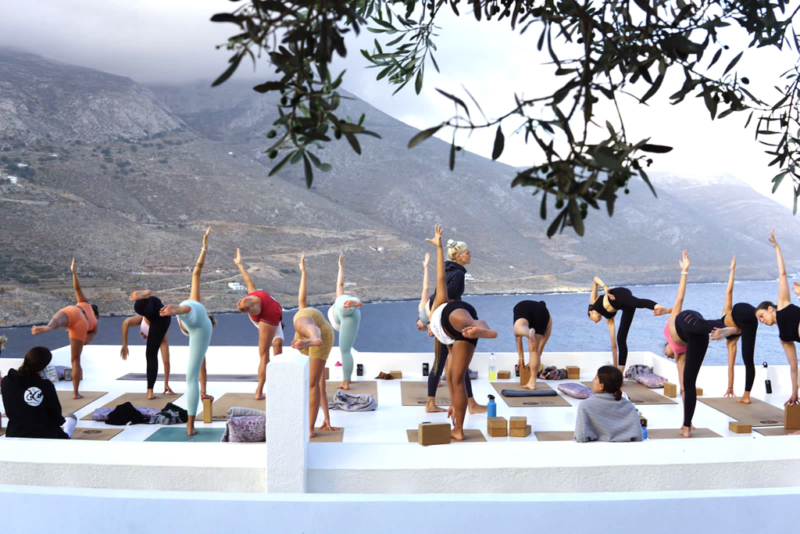Information


Understanding the differences between working out and a yoga asana practice.
It is quite common these days for some people to think of asana practice as a workout. I have seen it many times in my classes, when students just want to “do a sweaty flow” or power practice. And this is ok, because asana practice has changed so much from its traditional form in many ways. From a yoga philosophy point of view, this gives the incorrect method and intention of practicing. From a more modern approach and more open point of view, this might not necessarily a bad thing because it brings people on the mat. And this is the most important. We all have to start somewhere. And at some point, on our practice journey, the essence of yoga will be revealed and this can only happen through practice, being guided by a teacher and with consistency.
They are both important and valuable lifestyle habits, just that they are different. And understanding how they differ, can help us make the most of what they provide.
Let’s look at some key differences between working out and asana practice.

If we think of a gym workout and an asana practice, one of the most noticeable differences between the two is in their environment. As you can clearly see in the image above, they are very different. A gym environment is filled with external distractions. There are machines everywhere, people moving around, often loud music and sometimes even TV screens etc. Almost always there would be mirrors, air cond and artificial lighting. It is in general a lively and busy atmosphere.
In a yoga practice, all we need is a quiet space, ideally without air cond or too much artificial lighting and our yoga mat. In a yoga shala/studio, the environment should be as clean and minimal as possible. This is following a more traditional approach. The shala should be quiet and provide enough space for the students’ mats, without any other distractions. Sometimes during the yoga teacher trainings, the team will ask me if I want any special decorations or displays to make it more beautiful. My students know from having been in my classes, that I like to keep everything minimal so that the students focus on their practice. Candles can be used, as well as and having the yoga props either by the side of the mat or stored away nicely, but otherwise it should be kept free and empty to provide the sense of space. This is because yoga is an internal practice and any outside material aspects can make it difficult to focus inward.
Taking from the point above, we can also see a big difference in what happens to our senses during a workout and in asana practice. In a workout, although we do need to focus, often times we use music, TV screens, our phones, or even chat to somebody during the workout to “make the time go faster” or to distract the mind from the physical effort. But in asana practice, there should be the least amount of external distractions so that we can focus on the practice, to feel and hear our breath with each asana and to be completely aware and present. There should be silence, simplicity, and complete mental focus. This is what some call mindfulness and in yoga what we call “practice with awareness”. In Hatha Yoga Pradipika it is mentioned that the practice should be done in silence and in solitude, only unless in the presence of the teacher or guru.

Asana is described by Sri Patanjali as “Sthira Sukham Asanam” which means steady comfortable posture. Although nowadays, often it is done at a fast pace and promoting faster and power type movement, traditionally, asana practice known as Hatha yoga, was done in a slow manner, not gentle, but at a slow and steady pace. This is because when done so, it stimulates the parasympathetic nervous system, therefore promoting a feeling of calm and tranquility, steadiness and balance. The breath should be regulated so that it is at a normal pace.
When we workout, the sympathetic nervous system is activated, which brings the heart rate up, sometimes we might feel out of breath or our breathing becomes very fast; often sweating happens and we get an instant energy boost during the training. We can also sweat during an asana practice, but if practiced traditionally, it is not due to fast, cardio like movements but due to the nature of the asana and breath together which makes toxins released from the body.
Even when we look at the more stronger and anatomically complex practices like Ashtanga Vinyasa, it is not done at a fast pace to exhaust the body and mind. It can be tough, but it is not done as a workout, but as a rhythmic and steady connection between the breath and the posture, which is called Vinyasa. This can be more challenging than just bouncing around from one asana to the next.
When we finish a workout, we might feel exhausted completely or fully energises and on a “high”, but after an asana practice the feeling would be calm, clarity and balance. This is one of the reasons we should never skip Savasana. Yes the body can indeed get tired, but the mind should be tranquil, more focused and steady.
Yoga is a philosophy and asana practice is just one part of it. Although focused on physical work, asana practice is still a spiritual practice. Whilst asanas are known to have benefits for the body, such as stretch or strengthen particular muscles, provide discomfort or stiffness relief etc, this is not the main aspect of the practice. Traditionally, it is to make the body strong and flexible enough, steady and balanced in body and mind to be still for meditation which is one of the higher spiritual practices. It is not to make the body fit or more attractive, or to lose fat or get toned.
These however are all objectives of working out and this is what physical exercise does. It is not a spiritual practice, but a physical practice, and an externally focused on. It can help one lose weight if they need to, or tone their muscles, get stronger, faster, leaner etc. Working out can also help to focus the mind and gain mental clarity, but through more dynamic approach and without the spiritual aspect.
This is why we don’t need to overcomplicate our practice or even to do many different asanas. They also don’t need to be anatomically complex, we just need to learn steadiness in them.
Finally it is important to know that yoga asana, although using the physical body, it is an internal practice. The breath should be regular and fluid, the mind focused and steady and attention should be directed inwards or at a drishti (focus point). Ideally there should be no music or mirrors or any other external stimulations in an asana practice because these only cause a distraction. If we want to be able to meditate, then we have to first steady the body and mind, practice sense withdrawal and focus.
In my opinion, it is good to have a balance between the two. If you work out, do it away from the asana practice and vice versa. Learn to use them both wisely and not mix them.